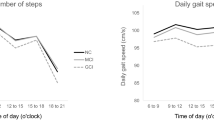Abstract
The purpose of this study was to compare gait pattern and cognitive function among elderly patients with Alzheimer’s Disease (AD), elderly people with Mild Cognitive Impairment (MCI), and Healthy Controls (HC). Twenty three elderly patients participated: 10 AD (77.2±6.84 yrs), 7 MC I(72.9±6.28 yrs), and 6 HC (71.6±5.78 yrs). Gait and Cognitive function were collected using an accelerometer attached to the foot and the Korean version of the Consortium to Establish a Registry for Alzheimer’s Disease (CREAD-K), respectively. To compare differences in gait performance among groups, mean stride time, magnitude and structure of gait variability and ratio of low frequency and high frequency (LF/HF ratio) of stride time sequence were used in this study. Results showed that gait variables (mean stride time, LF/HF ratio of stride time) were useful for classification between MCI and HC. Cognitive function (T1, T3, T4, T6, and T8 of CREAD-K) represented the difference between AD and HC. This study may provide a foundation for future work on progression of dementia.
Similar content being viewed by others
References
Morgan, D., Funk, M., Crossley, M., Basran, J., Kirk, A. and Dal Bello-Haas, V., “The Potential of Gait Analysis to Contribute to Differential Diagnosis of Early Stage Dementia: Current Research and Future Directions,” Canadian Journal on Aging, Vol. 26, No. 1, pp. 19–32, 2007.
Kim, J., Kim, C., Lee, J., Kwon, Y., Eom, G., Tak, G. and Hong, J., “Human Postural Control against External Force Perturbation Applied to the High-back,” Int. J. Precis. Eng. Manuf., Vol. 10, No. 4, pp. 147–151, 2009.
Huang, C., Mattis, P. and Julin, P., “Identifying functional imaging markers of mild cognitive impairment in early Alzheimer’s and Parkinson’s disease using multivariate analysis Identifying functional imaging markers of mild cognitive impairment in early Alzheimer’s and Parkinson’s disease using multivariate analysis,” Clinical Neuroscience Research, Vol. 6, No. 6, pp. 367–373, 2007.
Carletti, T., Fanelli, D. and Guarino, A., “A new route to non invasive diagnosis in neurodegenerative diseases?” Neuroscience Letters, Vol. 394, No. 3, pp. 252–255, 2006.
Nakamura, T., Meguro, K. and Sasaki, H., “Relationship between falls and stride length variability in senile dementia of the Alzheimer type. Relationship between falls and stride length variability in senile dementia of the Alzheimer type,” Gerontology, Vol. 42, No. 2, pp. 108–113, 1996.
Wittwer, J. E., Webster, K. E., Andrews, P. T. and Menz, H. B., “Test-retest reliability of spatial and temporal gait parameters of people with Alzheimer’s disease,” Gait & Posture, Vol. 28, No. 3, pp. 392–396, 2008.
Allan, L. M., Ballard, C. G. and Burn, D. J., “Prevalence and Severity of Gait Disorders in Alzheimer’s and Non-Alzheimer’s Dementias Prevalence and Severity of Gait Disorders in Alzheimer’s and Non-Alzheimer’s Dementias,” Journal of the American Geriatrics Society, Vol. 53, No. 10, pp. 1681–1687, 2005.
Hausdorff, J. M., “Gait dynamics, fractals and falls: Finding meaning in the stride-to-stride fluctuations of human walking,” Human Movement Science, Vol. 26, No. 4, pp. 555–589, 2007.
Merory, J. R., Wittwer, J. E., Rowe, C. C. and Webster, K. E., “Quantitative gait analysis in patients with dementia with Lewy bodies and Alzheimer’s disease,” Gait & Posture, Vol. 26, No. 3, pp. 414–419, 2007.
Scherder, E., Eggermont, L., Swaab, D., van Heuvelen, M., Kamsma, Y., de Greef, M., van Wijck, R. and Mulder, T., “Gait in ageing and associated dementias; its relationship with cognition,” Neuroscience & Biobehavioral Reviews, Vol. 31, No. 4, pp. 485–497, 2007.
Yan, J. H., Rountree, S., Massman, P., Doody, R. S. and Li, H., “Alzheimer’s disease and mild cognitive impairment deteriorate fine movement control,” Journal of Psychiatric Research, Vol. 42, No. 14, pp. 1203–1212, 2008.
Lee, J. H., Lee, K. U., Lee, D. Y., Kim, K. W., Joo, J. H., Lee, K. H., Kim, S. Y., Han, S. H. and Woo, J. I., “Development of the Korean version of the Consortium to Establish a Registry for Alzheimer’s Disease(CERAD) Assessment Packet: clinical and neuropsychological assessment Batteries,” Journal of Gerontology B Social Sciences, Vol. 57, pp. 47–53, 2002.
Peng, C. K., Havlin, S., Stanley, H. E. and Goldberger, A. L., “Quantification of scaling exponents and crossover phenomena in nonstationary heartbeat time series,” Chaos, Vol. 5, No. 1, pp. 82–87, 1995.
Webster, K. E., Merory, J. R. and Wittwer, J. E., “Gait Variability in Community Dwelling Adults With Alzheimer Disease,” Alzheimer Disease & Associated Disorders, Vol. 20, No. 1, pp. 37–40, 2006.
O’Keeffe, S. T., Kazeem, H., Philpott, R. M., Playfer, J. R., Gosney, M. and Lye, M., “Gait Disturbance in Alzheimer’s disease: A Clinical Study,” Age & Aging, Vol. 25, No. 4, pp. 313–316, 1996.
Hausdorff, J. M., Zemany, L., Peng, C. K. and Goldberger, A. L., “Maturation of gait dynamics: stride-to-stride variability and its temporal organization in children,” Journal of Applied Physiology, Vol. 86, No. 3, pp. 1040–1047, 1999.
Choi, J. S., Kang, D. W., Mun, K. R., Bang, Y. H. and Tack, G. R., “Development of gait event detection algorithm using an accelerometer,” Korean Journal of Sport Biomechanic, Vol. 19, No. 1, pp. 158–166, 2009.
Verghese, J., Robbins, M., Holtzer, R., Zimmerman, M., Wang, C., Xue, X. and Lipton, R. B., “Gait Dysfunction in Mild Cognitive Impairment Syndromes,” Journal of the American Geriatrics Society, Vol. 56, No. 7, pp. 1244–1251, 2008.
Owings, T. M. and Grabiner, M. D., “Step width variability, but not step length variability or step time variability, discriminates gait of healthy young and older adults during treadmill locomotion,” Journal of Biomechanics, Vol. 37, No. 6, pp. 935–938, 2004.
Author information
Authors and Affiliations
Corresponding author
Rights and permissions
About this article
Cite this article
Choi, JS., Oh, HS., Kang, DW. et al. Comparison of gait and cognitive function among the elderly with Alzheimer’s Disease, Mild Cognitive Impairment and Healthy. Int. J. Precis. Eng. Manuf. 12, 169–173 (2011). https://doi.org/10.1007/s12541-011-0024-9
Received:
Accepted:
Published:
Issue Date:
DOI: https://doi.org/10.1007/s12541-011-0024-9



